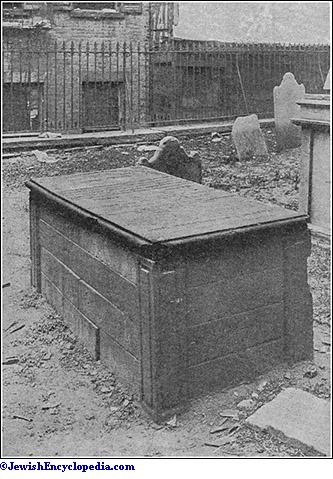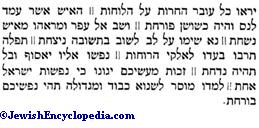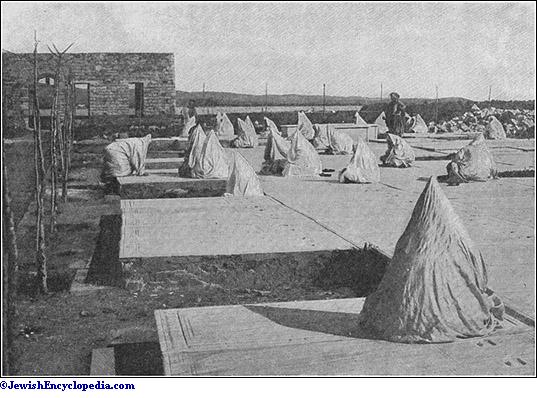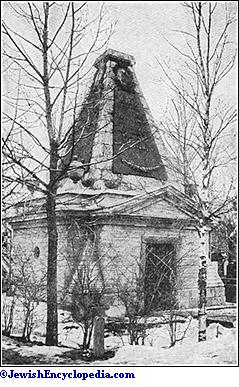TOMBSTONES (Hebr.  , pl.
, pl.  ):
):

The custom of marking a grave by a stone which bore an inscription describing the qualities of the deceased and giving his age and the date of his death was foreign to the ancient Hebrews. Stones were indeed used to mark the sites of graves, such as the pillar ("maẓẓebah") placed by Jacob on the tomb of Rachel (Gen. xxxv. 20), and the sign ("ẓiyyun") set up according to Ezekiel (xxxix. 16); but they were not intended as monuments and bore no inscriptions. Even in the geonic period the custom seems to have been unknown to the Jews of the East, and it can not, therefore, have been current in Talmudic times. The stone termed "golel" in the Mishnah (Oh. ii. 1), which, according to Hai Gaon, was laid up on the side-walls (dofeḳin), served only to protect the grave from jackals, while that called "ẓiyyun" was merely a mark to warn passers-by against Levitical impurity. Graves in Palestine were not devoid of monumental ornamentations, however, for "nefashot," or stone buildings in the shape of houses or cupolas, were erected, in Phenician fashion, over them ('Er. v. 1; Sheḳ. ii. 5). On the tomb of his father and brothers at Modin, Simon Maccabeus erected a monument consisting of seven pyramids on which were carved armor andships (I Macc. xiii. 27-29). Such monuments became the fashion in the first centuries of the common era, while the rivalries which arose between families, and the love of ostentation, led to the spending of great sums for the adornment of graves. To put an end to this extravagance Simeon ben Gamaliel declared that the pious were remembered by their words, and that it was an insult to their memory to put monuments on their graves as though they would have been forgotten without them (Yer. Sheḳ. ii. 7, 47a). It was only outside Palestine that some Jews, adopting the custom of the Greeks and the Romans, began to use tombstones with inscriptions commemorating the status of the deceased. These epitaphs were written in Greek or Latin in the first centuries of the common era, and began with the name of the deceased or with the introductory phrase Ἐνθάδε καῖται (κεὶται) or "Hic j a c e t" (= "Here lies"), while eulogies recalling Biblical verses and idioms were used as final formulas, as, for instance, Isa. lvii. 2 or Ps. iv. 9. The stones were adorned with a variety of symbols in addition to the epitaphs themselves, the most common being a seven-branched candlestick (in allusion to Prov. xx. 27, "The spirit of man is the candle of the Lord"), a fruit from which sprang an ear of grain (probably an allusion to the resurrection of the dead), an oil-vessel, a palm-branch, or a curved horn representing the Shofar which will be blown by the Messiah to announce the resurrection of the dead. Except for the presence of these symbols, the Jewish tombstones of the first centuries of the common era could not be distinguished from those of the Christians. Later gravestones, however, bore, in addition to the Greek or Latin inscription, the Hebrew formula  , as does the tombstone of Narbonne of 688; or else they had a Hebrew translation of the Greek or Latin inscription, as does that of Tortosa.
, as does the tombstone of Narbonne of 688; or else they had a Hebrew translation of the Greek or Latin inscription, as does that of Tortosa.
It can not be determined with certainty when the custom of inscribing Hebrew epitaphs on tombstones first became general among the Jews in Europe. The oldest example known is a gravestone of Brindisi dated 832. It is true that Jacob Mölln (MaHaRIL) asserts that in his lifetime a gravestone was discovered in the cemetery of Mayence bearing a Hebrew epitaph which was eleven hundred years old, but as he does not state that he himself deciphered the inscription, no credence can be given to his assertion ("Liḳḳuṭe Maharil," ed. Warsaw, p. 86b). A characteristic feature of the epitaphs of the early Middle Ages was the simplicity of their style. They usually began with the words  ,
,  , or
, or  , and closed with one of the usual eulogies (see Invocation).
, and closed with one of the usual eulogies (see Invocation).

In the later medieval period epitaphs became more detailed and bombastic, and in some German cemeteries various emblems representing the profession of the deceased were added to the inscriptions. Thus, for instance, a tailor had a pair of shears on his tombstone; a musician, a violin or a harp; a goldsmith, a crown and two chains; a physician, a lion holding a sword; and an apothecary, a mortar. In some places in Germany the tombstones bore the emblems of the houses in which the deceased had lived, thus showing figures of dragons, bears, lions, or stars. The tombs of kohanim are distinguished by two open hands as placed during the priestly benediction, while a Levite's gravestone often bears a ewer. Names, especially those derived from plantsor from animal life, are frequently represented pictorially; and reliefs of the whole human body are found.
Inscriptions.The form of the tombstone was generally very simple; and the material varied considerably in different countries. In Frankfort-on-the-Main gravestones were generally made of red sandstone, rarely of white sandstone or granite. The Ashkenazim usually placed the tombstones upright, while the Sephardim laid them horizontally on the graves. The custom of carving Hebrew inscriptions on gravestones seems to have developed much later in the East than in Europe, since there is no mention of it in geonic literature. Although Benjamin of Tudela attributes the dearth of very ancient tomb-stones in Palestine to the fact that the Christians destroyed the Jewish graves and used the stones for building-material, this is a mere supposition, and there is no proof whatever that the use of tombstones with Hebrew inscriptions became general in Palestine much earlier than the twelfth century. It is true, on the other hand, that both in the lifetime of Benjamin of Tudela and for several centuries afterward Jewish graves were often destroyed and the stones were used for building purposes in Christian and Mohammedan countries alike. Thus, when the Jews were banished from Fürth, the gravestones of the community were used to erect walls around the city; and David ibn Abi Zimra (sixteenth century) relates that in his lifetime the Egyptian Mohammedans used to steal Jewish tombstones and resell them to Jews after having obliterated the inscriptions. To put an end to this traffic, the local rabbis allowed their congregations to use only newly quarried stones for monuments to the dead (Radbaz, i. 741, quoted by Abrahams, "Jewish Life in the Middle Ages," p. 78). Although tombstones became customary, they were not obligatory (Shulḥan 'Aruk, Yoreh De'ah, 364), and every Jewish cemetery contains some graves without them. The stone was seldom set up before the expiration of a year after the date of death, since the departed soul required that lapse of time before it could be purified. Inscriptions are generally dated according to the era of creation; and the year is preceded by the day of the month, or the Sabbatical section, or both. In some cases the numerical value of a Scriptural phrase is used to mark the date, and there are also instances in which the Christian date is given side by side with the year of creation.
The following are specimens of Hebrew inscriptions found on the tombstones of prominent men. The gravestone of Elijah Levita reads: 

"The stone crieth from the wall, and mourneth before every passer-by over the grave—over our rabbi who hath departed and ascended into heaven. Elijah is gone to the Lord in a whirlwind [comp. II Kings ii. 11]—he who shed light on the darkness of grammar and turned it into light. He ascended Shebaṭ toward the end, in the year 309 [ = 1549], and his soul is bound up in the bundle of life."
The following epitaph is found on the tombstone of Leon of Modena: 


"Four yards of ground in this graveyard, 'by purchase by kerchief,' were from eternity transferred from above to Judah Aryeh of Modena. In these he hid himself and disappeared."
Manasseh ben Israel's tombstone bears the words: 
"The rabbi did not die; his light is not yet extinguished; he liveth still in the heights of the Terrible. By his pen and the sweetness of his speech his remembrance will be eternal like the days of the earth."
On the tombstone of Joseph Delmedigo is found the following inscription: 

"Take up weeping, wailing, and lamenting, howl in mourning and desolation, suffer bitterness like wormwood, for a chiefand a great man is fallen in the camp, one who was the crown of the inherited [sciences, i.e., Jewish learning] and astronomy. Wisdom was lost [with him] and understanding disappeared. Is there one like him in clime or country—west, east, south, north—to whom the spirit of God hath been given? His wisdom singeth in the streets, while his soul, under the wings of the Shekinah, is hidden and preserved. Hasten, break out in lamentations and howlings over the man, the pride of Israel who hath passed away [the phrase
is merely a rhetorical figure in imitation of Gen. xv. 17]. For he is the Joseph who sold corn [i.e., propagated learning; comp. Gen. xlii. 6], whose reputation spread everywhere, who tore up mountains and broke rocks. Nothing was hidden from him. In a tongue that speaketh proud things he composed works. In the 'Noblot Ḥokmah' he creditably speaketh of astronomy and ''ibbur.' To compose many works was his intention and desire. In all the seven sciences he was very efficient. He omitted nothing, small or great; he collected and thesaurized everything."
The tombstone of Moses Ḥagiz bears the epitaph: 
 [read:
[read:  ]
] 
"Passer-by, turn toward me, read something beseeming: Underneath me a man prepared his dwelling-place. Yesterday the light of his face shone majestically, showing his greatness and sovereignty; to-day clods of earth encompass the beauty of his body and its brilliancy. It hath neither bodily form nor substance; we can compare naught unto it. It behooveth thee only to keep thine eyes open; know that, like him, as a still-born child thou wilt fall in its [death's] trap. Beware of the last day, for the wise man foreseeth the end from the beginning."
Some prominent men composed for themselves the epitaphs which they wished to be put on their tombstones, such as the one found on the gravestone of Jonathan Eybeschütz, which reads as follows: 
"Every passer-by should see what is engraved on these tables. The man who stood as a model, who flourished like a lily, returned to dust, and his visage became marred more than any man's. Pray, take it to heart to repent sincerely and to offer for him many prayers to the Lord of spirits that He should gather to Him his soul, and not cast it away. The merit of your deeds will be a protection, for all the souls of Israel are one. Learn to despise honors and to flee from greatness."

See, also, the articles Burial, Cemetery, and Paleography.
- Perles, Die Leichenfeierlichkeiten des Nachbiblischen Judenthums, in Monatsschrift, 1860;
- Geiger, Zeitschrift für die Gesch. der Juden in Deutschland, iii. 211 et seq.;
- Bender, Beliefs, Rites, and Customs of the Jews Connected with Death, Burial, and Mourning, in J. Q. R. 1894, 1895;
- S. Rapoport, Gal 'Ed, Introduction;
- Horowitz, Inschriften des Alten Friedhofs, Introduction, Frankfort-on-the-Main, 1901;
- Schuchostov, Maẓẓebat Ḳodesh, Introduction, Lemberg, 1863-69.
The shape of Jewish tombstones varies, as a rule, according to the country in which they are found,though occasionally the Jews carry with them to other countries the practise of their native land. No very careful examination of the development of Jewish tombstones has hitherto been made; but it appears probable that in the earlier instances the grave of an important personage was covered by a stone in the shape of a sarcophagus, at the end of which a description of the person interred beneath it was incised. This is clearly shown in the collection of tombstones in the old Sarajevo cemetery (see
With the Ashkenazim, on the other hand, the foot-piece, possibly for economy's sake, was detached from the sarcophagus, and the inscription was incised upon it, apparently on the outside of the grave, as in the case of the Brody cemetery (ib. iii. 640), where obviously the inscriptions which abut on the path must be at the ends of the graves, since the latter would otherwise be under the path. Afterward the inscription was cut on the interior of the upright stone, i.e., the portion facing the tomb itself.
The earliest form seems to have been a plain, square, somewhat thick stone, as at Mayence, with which may be compared the Seville tombstone illustrated in

In western Europe and America, Jewish tombstones have become exactly similar to those of the surrounding population. Thus, in the United States the stone put over Moses Seixas is a plain square slab of the old-fashioned type (ib. xi. 161); that over Judah Touro is a short obelisk (ib. ix. 295), while the monument over the grave of Uriah Levy is in its way quite a work of art, and has distinct reference to his naval career (ib. viii. 65). In the richer Jewish families the gravestone has already been replaced by a family vault of a somewhat elaborate character. Reference to the following illustrations in
| Altona | i. | 475 |
| Amsterdam | i. | 544 |
| Brody | iii. | 640 |
| Delmedigo, Joseph | iv. | 509 |
| Dessan | iv. | 535 |
| Endingen | iii. | 639 |
| Frankfort-on-the-Main | iii. | 638 |
| Gans, David | v. | 566 |
| Isaac ben Sheshet | vi. | 632 |
| Judah Löw ben Bezaleel | vii. | 534 |
| Levy, Uriah Philips | viii. | 65 |
| London | viii. | 158 |
| Mayence | viii. 386, | 387 |
| Meisel, Mordecai | viii. | 442 |
| Mendelssohn, Moses | viii. | 484 |
| New York | i. 511; iii. 641; ix. 284, | 288 |
| Newport | i. 510, ix. | 295 |
| Nikolsburg | ix. | 306 |
| Pisa | x. | 61 |
| Prague | x. | 165 |
| Saint Petersburg | x. 643, | 645 |
| Sarajevo | xi. | 60 |
| Seixas, Gershom Mendez | xi. | 160 |
| Seixas, Moses | xi. | 161 |
| Seville | xi. | 208 |
| Tunis | xii. | 276 |
| Vienua | xii. | 438 |
| Wertheimer, Samson | xii. | 504 |
| Worms | xii. | 562 |
- Admirable examples of old tombstones are given in H. de Castro, Keur van Grafsteenen, Leyden, 1883, and in L. Jerabek, Der Alte Prager Juden-Friedhof, 1903.





